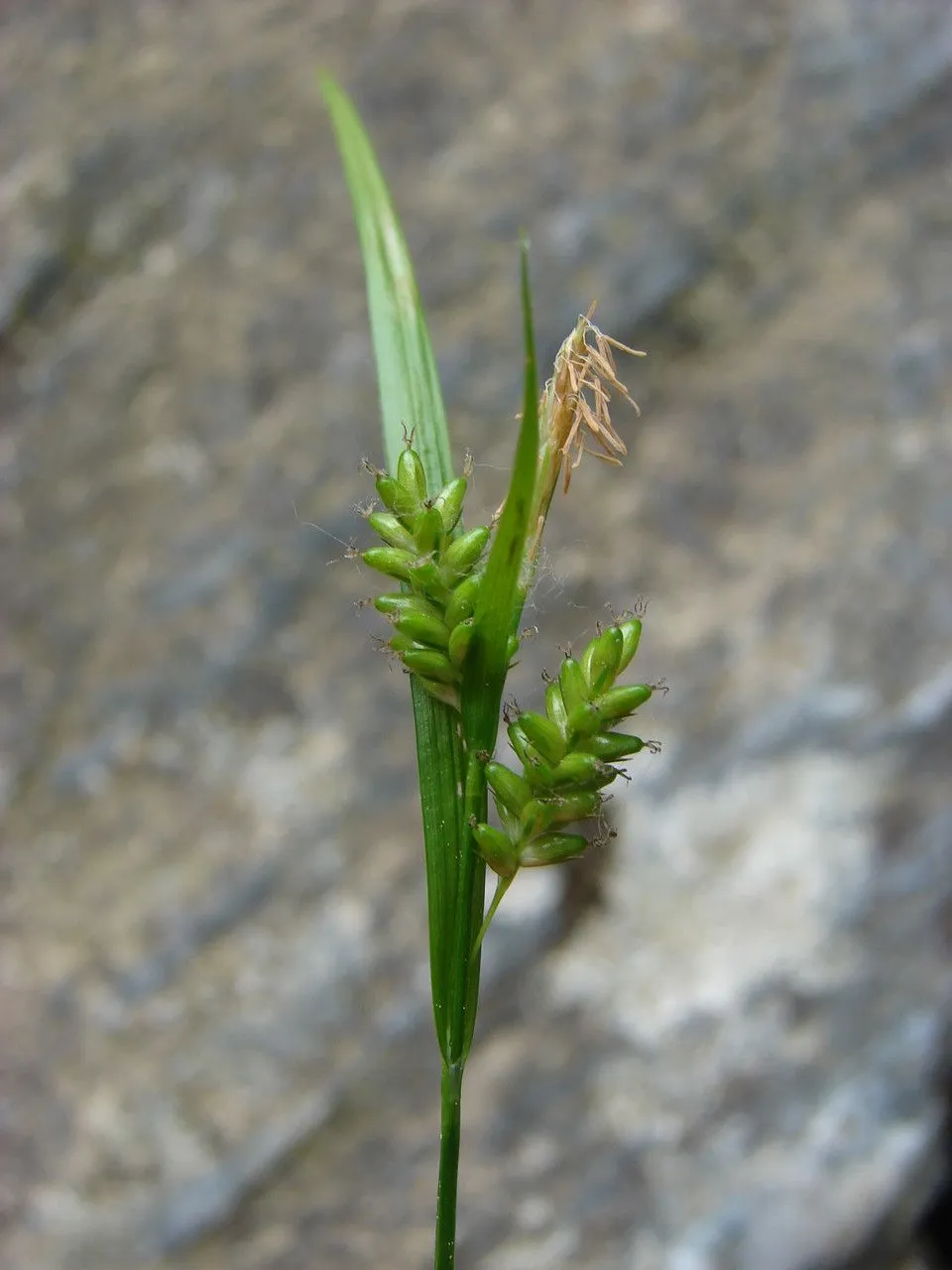
Author: L.
Bibliography: Sp. Pl.: 977 (1753)
Year: 1753
Status: accepted
Rank: species
Genus: Carex
Vegetable: False
Observations: Europe to C. Asia, E. Canada to NC. & NE. U.S.A.
The Pale sedge, scientifically known as Carex pallescens, is a significant species within the family Cyperaceae. First described by the renowned taxonomist Carl Linnaeus in his seminal work Species Plantarum in 1753, this plant has garnered recognition for its extensive geographic distribution and its ecological importance.
Carex pallescens can be commonly found across a vast expanse that includes Europe, Central Asia, Eastern Canada, and the northeastern and north-central regions of the United States. Its adaptability to a variety of temperate climates highlights its ecological versatility.
Characteristics of the Pale sedge include its distinctive pale green leaves and dense, tufted growth habit. This perennial sedge typically favors moist, shaded environments such as meadows, woodlands, and riverbanks, where it plays an integral role in stabilizing soil and supporting local biodiversity. The inflorescence of Carex pallescens consists of small, inconspicuous flowers that bloom from late spring to early summer, contributing to the plant’s understated beauty and charm.
Ecologically, the Pale sedge serves as an important species in various habitats. It provides food and shelter for a diverse array of wildlife, including insects, birds, and small mammals. The plant’s root system helps prevent soil erosion, making it a valuable component in habitat restoration and conservation projects.
Traditionally, members of the Cyperaceae family, including Pale sedge, have been utilized in various cultural and practical applications, although Carex pallescens itself is more commonly noted for its ecological rather than its economic or medicinal uses.
In summary, Carex pallescens—the Pale sedge—is a modest yet vital species that contributes to the health and stability of the ecosystems it inhabits. Its widespread distribution across continents underscores the plant’s ecological significance and adaptive resilience.
Dan: bleg star
Deu: bleiche segge
Eng: pale sedge, pale green sedge, pale meadow sedge
Nor: bleek-star
Nob: bleikstarr
Nno: bleikstorr
Nld: bleke zegge
Swe: blekstarr, kalvassara
Fin: kalvassara
Fra: laîche pâle, carex pâle, laiche pâle
Sme: šovkeslukti
Cym: hesg gwelw, hesgen welw, hesgen welwlas
En: Pale sedge, Pale green sedge, Pale meadow sedge
Bg: Бледа острица
Ca: Càrex pal·lescent
Cs: Ostřice bledavá
Da: Bleg Star
Nl: Bleke zegge
Et: Kahkjas tarn
Fi: Kalvassara
Fr: Laîche pâle, Carex pâle, Laiche pâle
De: Bleich-Segge, Bleiche Segge
It: Carice verde-pallida
Lv: Bālganais grīslis
Se: Šovkeslukti
No: Bleek-star
Nb: Bleikstarr
Nn: Bleikstorr
Pl: Turzyca blada
Ru: Осока бледноватая
Sv: Blekstarr, Kalvassara
Cy: Hesgen welw, Hesg Gwelw, Hesgen Welwlas
Taken May 14, 2015 by Tela Botanica − Paul FABRE (cc-by-sa)
Taken May 14, 2015 by Tela Botanica − Paul FABRE (cc-by-sa)
Taken May 14, 2015 by Tela Botanica − Paul FABRE (cc-by-sa)
Taken May 14, 2015 by Tela Botanica − Paul FABRE (cc-by-sa)
Taken Jun 18, 2016 by Tela Botanica − Yoan MARTIN (cc-by-sa)
Taken Jun 18, 2016 by Tela Botanica − Yoan MARTIN (cc-by-sa)
Taken Jun 18, 2016 by Tela Botanica − Yoan MARTIN (cc-by-sa)
Taken Jun 18, 2016 by Tela Botanica − Yoan MARTIN (cc-by-sa)
Taken Jun 8, 2018 by Tela Botanica − Liliane ROUBAUDI (cc-by-sa)
Taken Jun 8, 2018 by Tela Botanica − Liliane ROUBAUDI (cc-by-sa)
Taken Apr 19, 2017 by Yoan MARTIN (cc-by-sa)
Taken Apr 19, 2017 by Yoan MARTIN (cc-by-sa)
Taken Jun 8, 2018 by Tela Botanica − Liliane ROUBAUDI (cc-by-sa)
Taken Jun 8, 2018 by Tela Botanica − Liliane ROUBAUDI (cc-by-sa)
Taken Jun 8, 2018 by Tela Botanica − Liliane ROUBAUDI (cc-by-sa)
Taken Jun 17, 2021 by Re He (cc-by-sa)
Taken May 20, 2022 by Jani Zadrgal (cc-by-sa)
Taken May 23, 2021 by Daniel Bourget (cc-by-sa)
Taken May 26, 2019 by marie claude claereboudt (cc-by-sa)
Taken Jun 18, 2016 by Tela Botanica − Yoan MARTIN (cc-by-sa)
Taken Apr 19, 2017 by Yoan MARTIN (cc-by-sa)
Taken May 20, 2012 by Tela Botanica − Liliane Roubaudi (cc-by-sa)
Taken Jul 7, 2018 by Tela Botanica − Jean-Claude Bouzat (cc-by-sa)
Taken Aug 3, 2012 by Tela Botanica − Jean-Louis CHEYPE (cc-by-sa)
Taken Jun 15, 2007 by Tela Botanica − Laurent PETIT (cc-by-sa)
Taken Jun 9, 2015 by Tela Botanica − Florent BECK (cc-by-sa)
© copyright of the Board of Trustees of the Royal Botanic Gardens, Kew.
Growth habit: Graminoid
Ph maximum: 5.5
Ph minimum: 5.0
Light: 7
Atmospheric humidity: 6
Soil nutriments: 3
Family: Myrtaceae Author: (F.Muell.) K.D.Hill & L.A.S.Johnson Bibliography: Telopea 6: 402 (1995) Year: 1995 Status:…
Family: Rubiaceae Author: Pierre ex A.Froehner Bibliography: Notizbl. Bot. Gart. Berlin-Dahlem 1: 237 (1897) Year:…
Family: Sapindaceae Author: Koidz. Bibliography: J. Coll. Sci. Imp. Univ. Tokyo 32(1): 38 (1911) Year:…
Family: Asteraceae Author: A.Gray Bibliography: Pacif. Railr. Rep.: 107 (1857) Year: 1857 Status: accepted Rank:…
Family: Fabaceae Author: Medik. Bibliography: Vorles. Churpfälz. Phys.-Ökon. Ges. 2: 398 (1787) Year: 1787 Status:…
Family: Aspleniaceae Author: (Cav.) Alston Bibliography: Bull. Misc. Inform. Kew 1932: 309 (1932) Year: 1932…